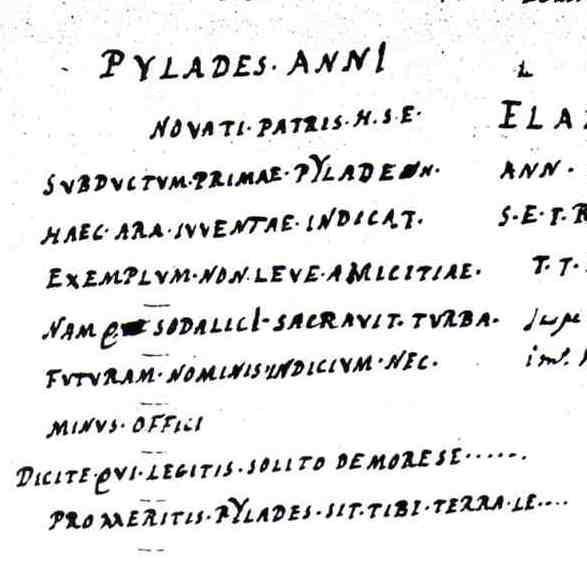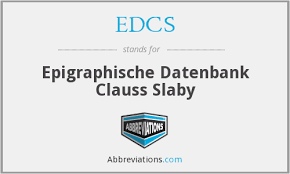Epitaph of Pylades
Reference CIL II 1293 | Description | Lyrics | Location | Chronology | Epigraphic edition | Translation | Apparatus | Comentary | Type of verse | Text divided into verses and metric signs | Images | Bibliography | Link to DB | Author |
Epitaph of Pylades
Description
- Idno filename 22/01/0049
- Type of inscription: Sepulcralis
-
Epigraphic field:
- Layout: Siruela offers information on the ordinatio: praescriptum with a first line in larger letters and a second centred line; carmen indented on the left and interpunction signs between all words except after offici (l. 8) and in solito de more (l. 9). Identification between epigraphical line boundaries in the pentameters, visually marking each elegiac distich as a whole; this explains the shortness of l. 8 and the wide blank space to its right; it could also indicate the separation from the last distich as a more common formula. <I> longae in l. 1, Anní and l. 6, sodalicí).
- Lost
Location
- Place of discovery: Found near Carmona and taken to Utrera in 1614.
- Geolocation
- Location with Modern Nomenclature España / Sevilla / Carmona
- Location with Old Nomenclature Hispania / Baetica / Astigitanus / Carmo
Chronology
- Inscription's dating: Between year 101 and year 199
- Dating explanation: The absence of the D.M. formula suggests a period before the 2nd c. AD.
Type of verse
- Type of verse: Dactílico (dístico elegíaco)
- Verse/line correspondence: No
- Prose/verse distinction: Si
Epigraphic edition
Pylades ▴ Anní
Novati ▴ patris ▴ h(ic) ▴ s(itus) · e(st) ▴
subductum ▴ primae ▴ Pyladen ▴
haec ▴ ara ▴ iuventae ▴ indicat ▴
5 exemplum ▴ non ▴ leve ▴ amicitiae ▴
namq(ue) ▴ sodalicí ▴ sacravit ▴ turba ▴
futur{a}<u>m ▴ nominis ▴ indicium ▴ nec ▴
minus ▴ offici
dicite · qui · legitis · solito de more sepulto
10 pro · meritis · Pylades · sit · tibi · terra · levis
Text divided into verses and metric signs
Subductum primae Pyladen haec ara iuventae ll|l/l|l/kk|l/l|lkk|l~
indicat exemplum non leve amicitiae, lkk|ll|l||lkk|lkk|~
namque sodalici sacravit turba futurum lkk|ll|l/l|ll|lkk|l~
nominis indicium, nec minus officii. lkk|lkk|l||lkk|lkk|~
5 Dicite qui legitis solito de more sepulto: lkk|l/kk|l/kk|l/l|lkk|l~
‘pro meritis Pylades sit tibi terra levis’. lkk|lkk|l||lkk|lkk|~
Translation
Pylades (slave) of Annius Novatus the father, lies here buried. This altar marks Pylades, snatched in his early youth and a noteworthy example of friendship. Indeed, a great many of his colleagues have dedicated this lasting memorial to his name and no less to his loyalty. You who are reading, say, in honour of the man buried here, as is customary: "For your merits, Pylades, may the earth rest lightly on you".
Bibliography
Caro 1622, 45 et 1634, 145v. (inde Doni ms. s. XVII, 14, 1; Muratori 1739–1742, 544 n. 3; Burmann 1759/73, 35; Mayans II, XLI; Meyer 1835, 1753; Hübner II 1293 [inde Bücheler, CLE 1103, cuius exemplum in linguam Hispanicam vertit Fernández Martínez 1998-99; Waltzing 1895–1900 III, 6–7, 44; Cholodniak 1904, 828; Vives, ILER 5801; Santero 1978, 77 et 154, 4; Ruiz Delgado 1985, 140; González Fernández 1988, 104–105, 57; id., CILA II 983; Thigpen 1995, 41–44, 3, quae in linguam Anglicam vertit]; id., cf. EE VIII p. 352); Siruela saec. XVII, 7 et 27 (inde Gimeno – Stylow 1998, 95– 96 et 143); ex eis Martín Camacho, CLEB ES, SE9, qui in linguam Hispanicam vertit. – Cf. Hübner 1899, 351–352; Mariner 1952, 45, 54, 69; Mangas 1971, 117 et 219; Sblendorio 1980, 262 et 274; Sanders 1991, 430, 6; Stylow 2001, 100–101; Hernández Pérez 2001a, 23, 24, 129, 154, 155, 249, 254 et 280; Cugusi 2007, 119.
Apparatus
3 Pyladem Caro 1634 sed Pyladen recte Caro 1622. – 6 nanq Caro 1622 et 1634; sodalicii Caro 1634 sed sodalici recte Caro 1622. – 7 futuram Caro 1622 et 1634, Siruela, Gimeno – Stylow, Stylow. – 8 offiici Caro 1622, officii Caro 1634, officci Ruiz Delgado errore typographico. – 9 more se… Siruela. – 10 terra le… Siruela.
Comentary
Funeral monument erected by members of a collegium tenuiorum, cf. l. 6 sodalici and turba, vid. Santero 1978, 77 and 154. L. 4 ara alludes to an object which is not the tablet with a titulus, which would have been found en la cara exterior de un edificio sepulcral o bien como inscripción individual debajo del nicho…mientras que el ara -tal vez sin inscripción…- estaría sobre el enterramiento dentro del recinto o edificio sepulcral (on the outer wall of a burial structure or else as an individual inscription below the niche…while the ara –possibly with no inscription…- would be above the grave within the burial area or building Stylow. Alliteration with <R> and <T> in ll. 6-7, sacravit turba futurum, and <N> and <M> in ll. 7-8: nominis indicium nec minus; other phonic resources in ll. 3 and 4: assonance between adjectives before penthemimers and the substantive at the end, primae…iuventae, to which is also joined, in final position, l. 5, amicitiae; also between l. 3, subductum and l. 5. exemplum; as well as in ll. 7-8, sodalici…futurum / …indicium… futuri; and in ll. 9-10, legitis…/ meritis…levis. The triple repetition of Pylades, the expression ara…indicat and indicium highlight the idea of the survival of the name through the epitaph. Pylades refers back to the mythological paradigm of the friendship between Pylades and Orestes, hence the lusus nominis highlighted in l. 5: exemplum non leve amicitiae, vid. Sblendorio; ll. 6-7, nominis indicium nec minus offici, the stone recalls this quality, also referred to in l. 10, pro meritis.
Author
- Author:J. Martín Camacho
- Last Update2024-02-25 19:01:54
You can download this





